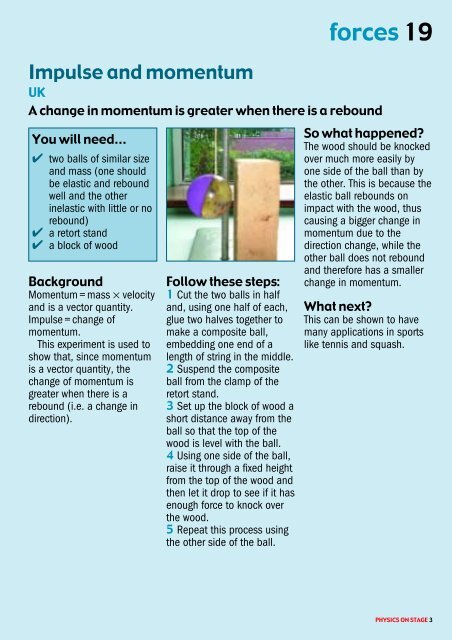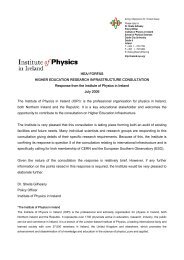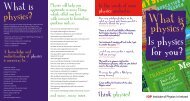PHY ICS - The Institute of Physics in Ireland
PHY ICS - The Institute of Physics in Ireland
PHY ICS - The Institute of Physics in Ireland
Create successful ePaper yourself
Turn your PDF publications into a flip-book with our unique Google optimized e-Paper software.
forces 19<br />
Impulse and momentum<br />
UK<br />
A change <strong>in</strong> momentum is greater when there is a rebound<br />
You will need...<br />
✔ two balls <strong>of</strong> similar size<br />
and mass (one should<br />
be elastic and rebound<br />
well and the other<br />
<strong>in</strong>elastic with little or no<br />
rebound)<br />
✔ a retort stand<br />
✔ a block <strong>of</strong> wood<br />
Background<br />
Momentum = mass × velocity<br />
and is a vector quantity.<br />
Impulse = change <strong>of</strong><br />
momentum.<br />
This experiment is used to<br />
show that, s<strong>in</strong>ce momentum<br />
is a vector quantity, the<br />
change <strong>of</strong> momentum is<br />
greater when there is a<br />
rebound (i.e. a change <strong>in</strong><br />
direction).<br />
Follow these steps:<br />
1 Cut the two balls <strong>in</strong> half<br />
and, us<strong>in</strong>g one half <strong>of</strong> each,<br />
glue two halves together to<br />
make a composite ball,<br />
embedd<strong>in</strong>g one end <strong>of</strong> a<br />
length <strong>of</strong> str<strong>in</strong>g <strong>in</strong> the middle.<br />
2 Suspend the composite<br />
ball from the clamp <strong>of</strong> the<br />
retort stand.<br />
3 Set up the block <strong>of</strong> wood a<br />
short distance away from the<br />
ball so that the top <strong>of</strong> the<br />
wood is level with the ball.<br />
4 Us<strong>in</strong>g one side <strong>of</strong> the ball,<br />
raise it through a fixed height<br />
from the top <strong>of</strong> the wood and<br />
then let it drop to see if it has<br />
enough force to knock over<br />
the wood.<br />
5 Repeat this process us<strong>in</strong>g<br />
the other side <strong>of</strong> the ball.<br />
So what happened?<br />
<strong>The</strong> wood should be knocked<br />
over much more easily by<br />
one side <strong>of</strong> the ball than by<br />
the other. This is because the<br />
elastic ball rebounds on<br />
impact with the wood, thus<br />
caus<strong>in</strong>g a bigger change <strong>in</strong><br />
momentum due to the<br />
direction change, while the<br />
other ball does not rebound<br />
and therefore has a smaller<br />
change <strong>in</strong> momentum.<br />
What next?<br />
This can be shown to have<br />
many applications <strong>in</strong> sports<br />
like tennis and squash.<br />
<strong>PHY</strong>S<strong>ICS</strong> ON STAGE 3













